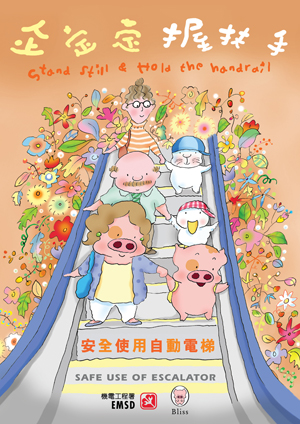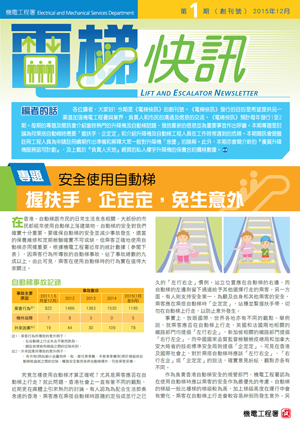|
Escalators are frequently used in our daily lives, so we must take every incident seriously. I as well as my colleagues from the Electrical and Mechanical Services Department (EMSD) attach great importance to the escalator incident that took place at Langham Place in Mong Kok on 25 March. A thorough investigation is being conducted by our EMSD colleagues, and preliminary investigation revealed that it was an extremely rare incident. As the metallic triplex drive chain was broken, and the broken chain safety device, which monitors the healthiness of the drive chain, was not activated as designed, the auxiliary brake therefore failed to stop the escalator in time. This double-failure is extremely rare, as there has never been any escalator incident in Hong Kong caused by the breakdown of the main drive chains and the dysfunction of the braking device at the same time. However, one accident is too many. Once the EMSD has completed the investigation, we will release the findings in detail as soon as possible to prevent similar incidents in future.
After the incident, the EMSD immediately required the relevant registered escalator contractors to conduct special inspections for all escalators with a vertical rise of 15 metres or above across the territory to ensure their safety. All the special inspections have been completed with no abnormality found. The EMSD also required the escalator contractor of Langham Place (i.e. Otis Elevator Company (Hong Kong) Limited) to conduct special inspections for all Otis escalators in Hong Kong within a month. The EMSD will scrutinise the arrangements, conduct sample checks and urge the contractor to proceed with caution.
Effective regulatory mechanism
The design, installation, maintenance, commissioning and examination of escalators in Hong Kong are regulated by the Lifts and Escalators Ordinance (the Ordinance) (Cap. 618). Under the Ordinance, escalators used in Hong Kong must undergo periodic maintenance by the registered escalator contractors and periodic examination by the registered escalator engineers. The EMSD will conduct sample checks of the relevant maintenance and examination work to see if there is any non-compliance. We will carefully review the findings of the investigation in this incident including whether human negligence was involved, take follow-up actions and deal with the issue carefully so as to restore public confidence in using escalators.
As regards the approval mechanism for different types of escalators, to ensure that the design of escalators comply with the standards set out by the EMSD, the Ordinance stipulates that for escalators and all their safety components installed in Hong Kong, written approval by the Director of Electrical and Mechanical Services (DEMS) must be obtained prior to installation works. The Ordinance also stipulates that after completion of the installation works of the escalators, the responsible person must arrange the escalator to be examined by a registered escalator engineer, certified to be in safe working order and granted a use permit by the DEMS before it is allowed to commence operation for public use.
Periodic maintenance, examination and repair
After a series of stringent approval procedures, the responsible person for an escalator must ensure that the escalator and all its associated equipment or machinery are kept in a proper state of repair and in safe working order as stipulated by the Ordinance. The responsible person has to cause a registered escalator contractor to undertake the maintenance and repair work of the escalator, and ensure that periodic maintenance should be carried out by a registered escalator worker at intervals of not exceeding one month, while periodic examination should be carried out by a registered escalator engineer at intervals of not exceeding six months. In addition, the Code of Practice for Lift Works and Escalator Works and the Code of Practice on the Design and Construction of Lifts and Escalators formulated by the EMSD set out the relevant design requirements for the safety components and the specifications for escalator installation and maintenance. We can see from the above that the EMSD has been strictly enforcing the codes, and we also firmly believe that the registered persons (including contractors, engineers and workers) are always duty bound to carry out periodic maintenance as appropriate, and the responsible person undertakes the management of the daily operation and repair of escalators in a professional manner. Taking all these into account, the public can rest assured that it is safe to use the escalators.
Be careful and hold the handrail tightly
It is, however, worth noting that most of the incidents that happened in the past three years (99.8 per cent) were not caused by equipment failure. In fact, 94.3 per cent of the incidents were related to passengers' behaviours, while 5.5 per cent were caused by external factors, for example, tiny foreign metal objects being caught in the gap between the step and the comb plate, thus triggering the safety device to stop the escalator. I also notice that the escalator incident at the Aberdeen Centre Shopping Arcade a few days ago involved a passenger who lost balance and fell down, causing the two passengers closely behind him to fall as well, and therefore the incident did not involve equipment failure either. As most escalator accidents can be avoided, escalator users should be aware of the following:
-
Hold the handrail tightly and stand still when using escalators. Do not run or play on escalators.
-
Do not only look at your mobile phone.
-
Children must be accompanied by adults when using escalators.
-
Senior citizens with impaired mobility, people in need and those carrying heavy objects such as baby prams, bicycles, wheelchairs or bulky baggage should use the lift.
-
Do not use escalators to transport goods.
-
Stand firm behind the yellow lines. Do not stand near the yellow lines.
-
Remember to lift your foot when stepping off the escalator. Avoid getting your shoes trapped in the gap between the step and the comb plate.
-
When wearing plastic shoes, flip-flops, sandals or long dresses, watch out for the gaps on the two sides of the escalator and those between the steps. Do not touch the brush bristles on the two sides of the escalator to avoid trapping of any objects.
-
Do not lean any part of your body beyond the escalator.
|
|
 |
| Remember to stand still and hold the handrail tightly when using escalators. |
 |
| Children must be accompanied by adults when using escalators and beware of the edges of the steps to avoid getting the feet caught in the gaps and causing accidents. |
 |
| The Electrical and Mechanical Services Department has already educated the public years ago on the safe use of escalators: Hold the handrail and stand still to avoid accidents. |
|